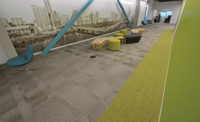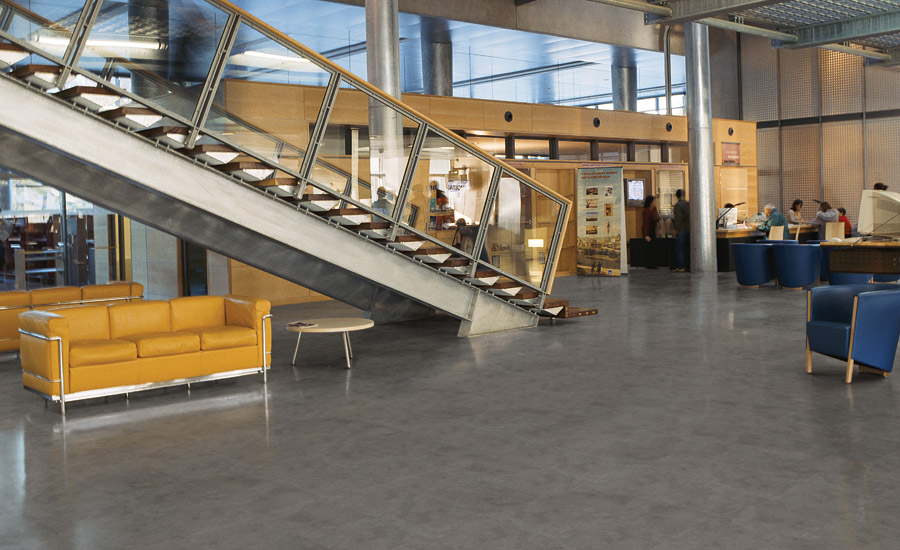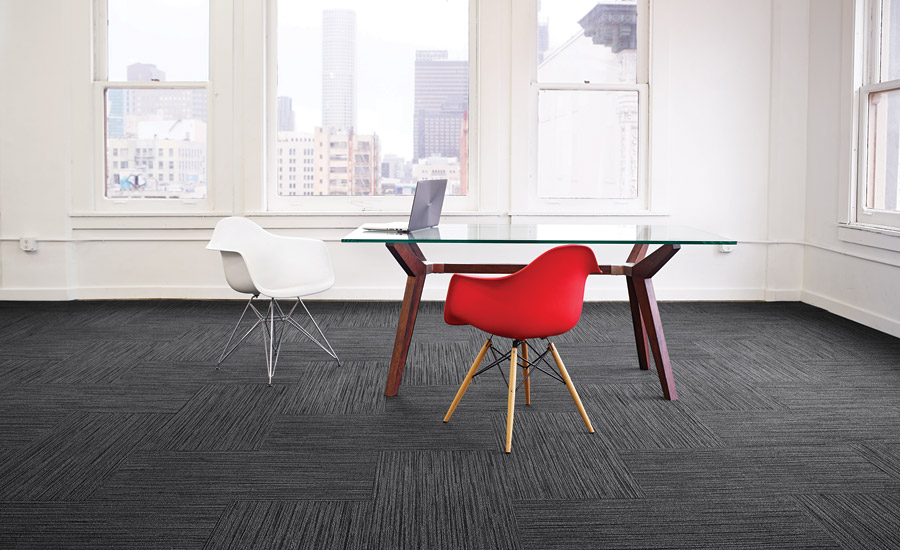Corporate Flooring Trends

Click systems like Gerflor’s Creation Clic System, shown here, offer high-style, high-performance flooring ideal for corporate renovations.

With its comfort, acoustic and design properties, carpet like Bentely Mills’ Shapeshifter remains a top choice for corporate spaces.

Metroflor’s Aspecta commercial luxury vinyl tile (LVT) features a high-performance coating and provides care and maintenance options that include a low-maintenance program.

As companies lean toward more open spaces to encourage collaboration, flooring can provide visual cues, define boundaries and assist with way-finding in these spaces. Shown here, Shannon Specialty Floors’ Fancy Free.






As corporate environments continue to evolve, so does the flooring in these spaces. From performance and design, to functionality and comfort, flooring in the corporate sector plays a large role in setting the tone for workplace collaboration, productivity and culture.
“Every sector impacts an audience; however, I would say the corporate sector is unique as it relates to employee productivity,” said Ellie Dowden, public relations and communications manager for Shannon Specialty Floors. “The corporate culture has engaged in a movement away from the stale, dull designs of the past and into researched spaces designed to optimize the productivity and happiness of its employees. With employees spending an average of nine hours a day in the office, its design has an opportunity to be very powerful.”
With everyday workplace rigors, long hours and demanding deadlines, creating appealing, accommodating and comfortable workspaces from the ground up is a key component to ensuring the satisfaction of current and future employees.
“The last several years have seen an evolution of the workplace to incorporate a residential feel, which adds comfort and encourages employees to engage for longer periods of time,” said Sherry Dreger, vice president of marketing for Bentley Mills.
In addition to incorporating comfort with a residential feel, the corporate sector has also started drawing inspiration from the hospitality sector in more recent years.
“Spaces are no longer cookie-cut for a 9-to-5 employee,” said Reesie Duncan, vice president of design for Shaw Contract. “Because people are spending more hours at the workplace, we’re seeing hints from the hospitality sector crossing over to incorporate more comfort—evolving to a more succinct, defined experience for users within a space.”
Careful planning goes into the flooring of corporate applications, as each space —from the reception area to the stock room—serves a different purpose and meets a different need. Be it visual appeal, comfort or functionality, designers are tapping into the latest design, color and material trends to create workspaces.
“Design mentality for the corporate workplace has evolved in the past several years,” said Duncan. “Flooring is no longer considered merely a finish requirement—but now serves as a primary basis for the project palette to enhance the architecture and meet the overall design intent.”
“Spaces are no longer cookie-cut for a 9-to-5 employee...Because people are spending more hours at the workplace, we’re seeing hints from the hospitality sector crossing over to incorporate more comfort—evolving to a more succinct, defined experience for users within a space.”
A longstanding forerunner in the sector, carpet tile remains a top choice in corporate applications due partly to its acoustic, comfort and ergonomic properties.
“Carpet, hardwood, resilient, ceramic and laminate are all in demand as spaces are built to suit by segment, performance requirements and aesthetic preference,” said Duncan. “Carpet tile is still a dominate preference in the marketplace, while demand for hard surface steadily increases.”
While carpet remains a top choice, designers are achieving durable, trend-setting looks quickly and cost-effectively with the help of luxury vinyl tile (LVT) and luxury vinyl planks (LVP).
“The corporate sector was predominantly the domain of carpet tiles for at least the last 30 years,” said Paul Eanes, vice president of sales, Metroflor. “While carpet remains the dominant floor of choice in the office environment, LVT/LVP has been specified in higher traffic areas, such as corridors, runways, hallways, kitchen areas and even some conference rooms.”
Interlocking [LVT] floor systems offer high style and performance, and they are ideal for corporate renovations, according to Catherine Del Vecchio, marketing manager of Gerflor USA. As the economy continues to steadily improve, more companies are finding room in their budgets for renovation—starting with the floors.
“As the economy continues to improve, projects that were put on hold are now getting back on track. Businesses now have more budget to reinvest, and they are choosing to create office designs that offer better working environments,” said Del Vecchio.
According to Dreger, not only does economic improvement speak to the increase of renovations in the corporate sector, but to the popularity of colors in the sector as well.
“Our industry is consistently pushing the mark on good design, sustainability and performance,” said Dreger. “Today, the corporate buyer has so many choices, they need to have a clear understanding of the particular needs and functionality of both the user and the space itself in order to determine the best product fit. Yes, the economy not only influences the numbers, but it also influences the color choices we see trending in corporate space.”
Warm grays, neutral tones, concrete designs and distressed looks are currently popular, and designers are achieving these looks with the simple click of an LVT plank and arrangement of carpet tile.
“Right now, the big trend in mid-century, loft and large new construction is concrete, to show the natural effect of the finishing process,” said Robert Langstaff, director of design, Metroflor. “This classic mix of wood, concrete and metal all become a part of the design, each in its own way. The trend of using and incorporating building materials into the environment as they are also follows in loft or old warehouse renovations where reclaimed and special finished woods continue to be important.”
To further encourage collaboration, some companies are getting rid of the infamous corner office, knocking down walls and opening up spaces to promote a more cohesive, creative and open workspace.
“I’ve seen a lot of companies do away with walls and welcome open spaces,” said Dowden. “Flooring helps break up these large spaces and add a design beyond just four outer walls. A unique and thoughtful floor design can aid in collaboration and organization.”
In these open spaces, flooring can help keep things organized by dictating a space’s function as well as boundaries in the workplace.
“In open office environments, the walls are down so clients depend on flooring to help provide visual cues, define boundaries and assist with way-finding,” said Duncan. “As the physical boundaries deconstruct, corporate flooring designs are also becoming less defined, more fluid and to accommodate scale and the idea of the ‘moveable path.’
Maintenance
When it comes to flooring selections for corporate spaces, choosing a proper maintenance plan and following maintenance guidelines is just as important as choosing a floor’s colors and designs.
“The best way to maintain flooring in any environment is to first ensure that the proper product is specified and selected for its intended usage,” said David Altman, director of R&D for Metroflor. “All floor coverings require some care to look their best, and many problems can be prevented before they occur. The area of usage, type and frequency of traffic on the floor, location within the building, amount of soil likely to be found in the location and end-user expectations will determine the type and frequency of maintenance needed.”
Whether it’s quickly vacuuming carpet or mopping LVT, regular maintenance to remove dirt and grit is imperative to getting the best value from a floor, as abrasion from dirt and grit is the single greatest cause of damage to any flooring or floor finish, according to Altman.
To help end-users keep their floors clean and looking good for years to come, manufacturers like Metroflor have developed cleaning products that help floors stand up to the everyday, high foot-traffic that corporate spaces see.
Shaw Contract has taken things a step further, making it easy for end-users to stay in-the-know of maintenance guidelines and procedures with just the click of a button.
“Shaw Contract Group provides on-site maintenance training if needed, as well as services like our online Maintenance and Cleaning Advantage (M.A.C.) and Floor Stain Center, our mobile phone app to assist maintenance teams for moving the most common flooring stains,” said Duncan.
Altman added, “Proper cleaning, care and maintenance are an essential part of keeping a floor safe and looking attractive, maintaining its appearance and extending the life of the investment.”
Looking for a reprint of this article?
From high-res PDFs to custom plaques, order your copy today!











